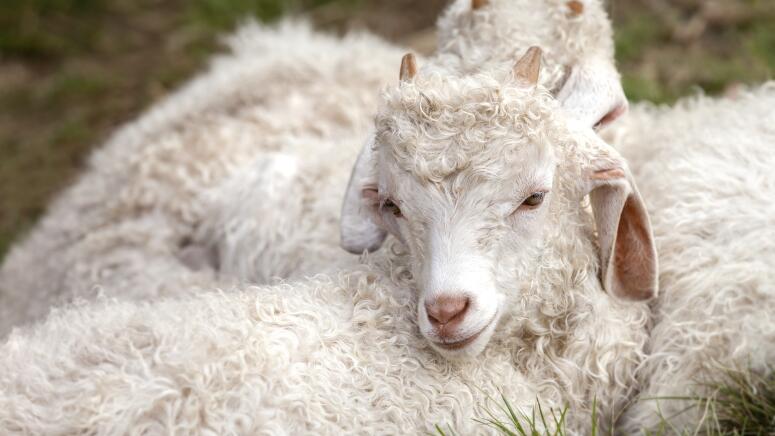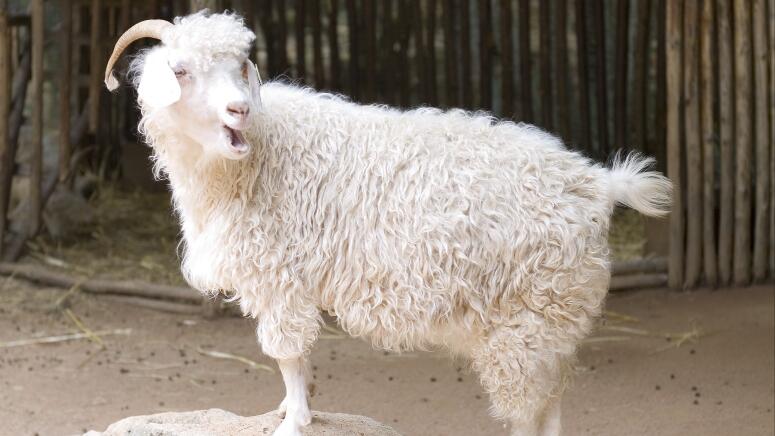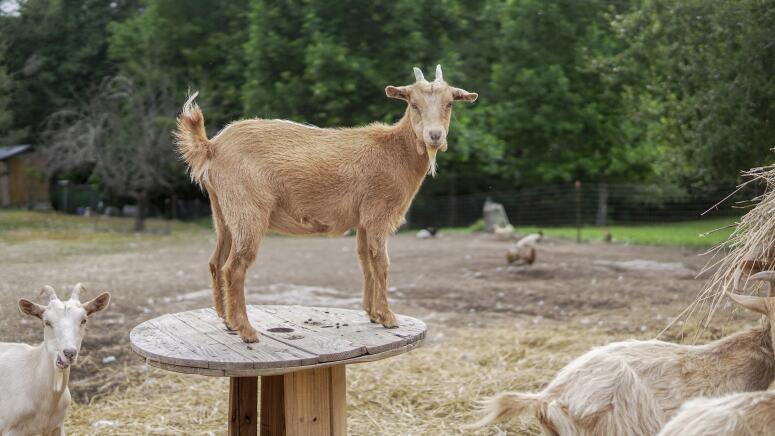Posted by Jennifer Sartell, Professional Homesteader & Blogger, Mon, Jun 22, 2015
Goat Dehorning
Dehorning is a touchy subject in the goat world, and rightly so. I can honestly understand both sides. There are those who believe that dehorning is cruel and goes against the natural biological makeup of a goat. There are others who believe that a horned goat, even if well behaved, is dangerous and could injure itself, a herd mate, a person or a child unintentionally. With wire goat fencing in which horns can become tangled, you add in the risk of strangulation or other injury.
Dehorning is my absolute least favorite part of raising goats, but it is often a necessary evil. Before you decide what to do about your kid’s horns, it’s important to be informed. Make your decision well in advance of kid season because there is only a small window of opportunity in which to perform a successful dehorning procedure.
The horns of a goat mainly perform two purposes. The first purpose, and the one that is perhaps not as well known, is to act as an air conditioning system during hot weather. The horns help regulate body temperature. This is why you never dehorn an Angora goat—the mohair fleece that the goat produces would easily overheat the animal and it could die in hot weather.

The second function of a horn, which is maybe more familiar, is for a goat to protect itself. Goats often communicate by “butting” things. They play by butting or can even show affection. Two of our girls ask for pets by “gently” ramming us in the thigh (it’s bittersweet love). When a goat is threatened, the horn communication becomes more aggressive. They will lower their head and flatten their ears toward their attacker. The thick plate at the base of the skull and the sharp horns act as a great defense system; in some ways it’s like two swords and a shield ready to fight off predators—or a competing buck.
Because we have a mixed herd of fiber and dairy goats, I’m used to being around goats with horns. All of our Angoras have horns, and we also have two Nubians who came to us with horns past the point at which it is safe to remove them (I’ll get more into that later).
We are lucky that none of our horned goats have caused injury to themselves or others. In our Angora herd, the females’ and wethers’ horns grow rather close to their heads. Since they curve back and leave mostly a smooth side exposed, they present only a small danger. Sulley, on the other hand, is our Angora buck. I consider him to be our most dangerous goat. Not because he’s a mean goat, but because he’s lively and doesn’t understand that he has two 13" curling spikes sticking out from the sides of his head.
He wants to jump and play like all the other goats, but carries around two spears everywhere he goes. He is not allowed around children or visitors to our farm. He’s even caught my husband and I by surprise a few times accidentally and we’ve had to nurse cuts and bruises caused by him. Bucks also become more aggressive during the rut, and when you combine 100 pounds of testosterone and more than two feet of horns Sulley can become a force to be reckoned with.
It’s not just the horns that are dangerous, but the horns in combination with a goat’s rambunctious personality. Unlike other horned animals, like sheep, goats are everywhere! They climb and jump up on things and people. They’re curious, determined and persistent, which makes accidents much more likely with a horned goat.
Another reason to dehorn your goat is that most fairs, such as 4-H, won’t allow goats with horns to be included. So, if you intend on showing or selling your goats at any point, dehorning is something you definitely want to consider.

How to Dehorn
I don’t even want to go into too much detail here because I don’t want this to serve as an instruction manual. I just want to provide enough information so you can understand what happens during the dehorning process. Dehorning should be done by a veterinarian or someone who is very, very experienced in the process. If dehorning is performed incorrectly, it can lead to brain damage or scurs later in life.
Scurs are horns that grow back partially because the whole horn was not “deadened”. Scurs are hard to control, can be dangerous to trim and can grow willy-nilly, sometimes curving into the goat’s skull. You also risk accidentally burning yourself or the goat kid in the eye or other places.
Dehorning should be done very early in the goat’s life—within the first two weeks, before the horns break through the skin. If the horn is allowed to grow much beyond this point, it becomes very dangerous to remove because a main artery grows down the horn and a goat could easily bleed to death. Dehorning is done with a hot iron and the horn buds are burned, killing the cuticle and stopping further growth.
Many people use an iron meant for calves, but we’ve found that this leaves an unnecessarily large scar, as calves’ horn buds are much larger than goats’. Instead, my husband, being a blacksmith, shaped a smaller steel iron that we use. We shave the kid’s head and secure them in place. Then we heat the iron and hold it on the horn bud for the correct amount of time. We look for changes in the color of the skin to ensure we’ve done it correctly.
It’s not a fun experience, but the goat kids bounce back quickly and it’s all over in a few seconds. Soon our kids are running and jumping around as if nothing happened. We can console ourselves by knowing that our goats will not cause injury later in life.

Wethering
A neutered buck is called a wether.
Wethering is another important decision that should be considered and decided upon well before your does gives birth. Unfortunately, in the dairy world, bucklings are not as useful as doelings. This isn’t the case in the Angora world, since wethers produce more fiber than does and bucks. This is because their bodies don’t have to put forth energy to produce hormones for mating and birthing. Most wethers produce beautiful fleeces!
Before you decide to wether, there are some things to be aware of.
For most of the year a buck goat is like any other goat. Our bucks are gentle, friendly and sweet. But all of this changes in late summer, when they go into rut. Rut is the sexual season for a male goat. Bucks in rut are… well… ridiculous!
They behave very, very strangely and they smell terrible! Some of the smell comes from a gland at the base of the skull which secretes a hormone that tells the ladies that he’s ready. The other smell is due to their habit of urinating on their faces and beards. Bucks in rut will howl, flap their tongues, ride all of their herdmates, urinate on their faces and beards, and rub on everything in sight, and can be aggressive toward you and other members of the herd—especially other bucks. They will also attempt to bust through fences and gates to get to your females.
Bucks can also affect the way the milk tastes in females. The buck emits a hormone that the female picks up on. Her body’s reaction to this hormone will affect how her milk tastes. It’s called “buck milk” and will taste musty and gross! This can happen year-round, so if you plan on keeping a buck be prepared to have an area in which to keep him away from your milking does.
If you plan to sell him as a buck or loan him out for stud service, be sure you have some interested parties. Make sure his lines are worth reproducing. People are usually finicky about keeping bucks and want a quality stud if they’re going to let him sire their herd. If you plan to use him for stud service, know that as he visits other farms he could potentially bring diseases from other goats back to your herd.
So… once you’ve considered all of this, if you decide that you’re ready and prepared for the challenge of raising a buck, then there’s nothing to be done but let him grow into the strapping lad he was always meant to be.
If not, then he should be wethered within the first two months of life. We wether using a banding system. We use a banding tool that stretches a small rubber band wide open. The stretched band is placed over the testicles up to where the scrotum meets the belly. The tool is then gently released and the prongs slide out, leaving the band to restrict blood flow to the testicles. Eventually the sac shrivels and dies, leaving the goat smooth and wethered. If you are concerned at all about wethering your own goat, please contact your veterinarian for further instruction.
Final Thoughts
There is so much more to raising kids that comes in the doing. I remember a time before we started with goats when reading article such as this one would leave my head feeling as though it were spinning. But don’t let intimidation scare you away from the joys that these beautiful animals can add to your life. Take each moment at a time and each procedure calmly, and remember—if you are unsure about anything, ask a professional.
Goat kids are worth every bit of time and effort that you put into them.
Author Profile: Jennifer Sartell
Jennifer Sartell is the primary caretaker of all animals on her and her husband’s farm in Fenton, MI. With a passion for living a simple life, Jennifer enjoys creating art, taking in nature, raising animals and has developed a deep appreciation for homesteading. Jennifer and her husband, Zach, currently raise goats and poultry.
Her vast amount of experience on the farm includes, but is not limited to: milking, shearing, hoof trimming, vaccine administration, assisting in animal births, dehorning, egg collecting, chick and turkey hatching, feeding, watering, etc. She can also cook a mean farm-to-table meal and when the day is done has documented and photographed their day on the farm.
More Blogs by Jennifer Sartell
- https://www.mannapro.com/homestead/caring-for-pregnant-does-part-2
- https://www.mannapro.com/homestead/caring-for-pregnant-does-part-1
- https://www.mannapro.com/homestead/preparing-caring-for-goats-in-winter
- https://www.mannapro.com/homestead/dairygoatbreeds
- https://www.mannapro.com/homestead/preparing-the-kidding-stall-part-2
- https://www.mannapro.com/homestead/a-guide-to-buying-a-new-goat
- https://www.mannapro.com/homestead/raising-kids-dehorning-wethering
- https://www.mannapro.com/homestead/milking-a-goat
- https://www.mannapro.com/homestead/raising-fiber-goats-101
- https://www.mannapro.com/homestead/hoof-care-for-goats
- https://www.mannapro.com/homestead/putting-together-a-goat-birthing-kit
- https://www.mannapro.com/homestead/preparing-the-kidding-stall-part-1
- https://www.mannapro.com/homestead/breaking-down-the-goat-diet
- https://www.mannapro.com/homestead/birthing-goat-kids
- https://www.mannapro.com/homestead/dealing-with-goat-scours
- https://www.mannapro.com/homestead/feeding-baking-soda-to-your-goats
- https://www.mannapro.com/homestead/pros-cons-and-facts-about-raising-turkeys
- https://www.mannapro.com/homestead/best-breeds-for-raising-chickens-with-children
- https://www.mannapro.com/homestead/a-guide-to-small-goat-breeds
Featured Products

